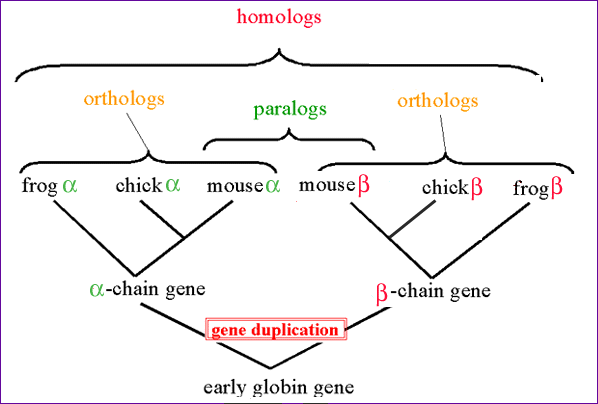class: center, middle # Comparative Genomics: Finding Orthologs and Paralogs --- # Grading / Project Discussion * Bonus Homework points (e.g. you only have to do 4 homeworks!) * If you want more Python/BioPython practice problems I am happy to provide... * Should be getting started on your analysis pipelines * Commit your script progress to repository. * Draw/Write out your plans for the steps your tools will perform * If you are stuck on something, ask sooner. --- # Comparative Genomics * Compare DNA/Genome content * Genes * Repeats and Transposable Elements * Compare gene order: Synteny * Overall DNA content * Gene order .left[] --- # Repeat Content Main tool for identifying Repetitive Elements: [RepeatMasker](http://www.repeatmasker.org/) De novo construction of a Repeat Library [RepeatModler](http://www.repeatmasker.org/RepeatModeler/) See example worked: https://github.com/biodataprog/code_templates/tree/master/Comparative ```bash #!/usr/bin/bash #SBATCH --ntasks 4 --nodes 1 --mem 16G module load RepeatModeler BuildDatabase -name elephant -engine ncbi elephant.fa RepeatModeler -engine ncbi -pa 4 -database elephant >& run.out ``` This produces a file consensi.fa.classified which can be used as a repeat library ``` >MOLLY_SN#DNA/TcMar-Fot1 RepbaseID: MOLLY_SNXX acgtacctcacgggttggccggacacacggtttggccggacacttttgcc aagcccccaccaaattctacctctcaacgtgatgcctcaacaacaacacc agatagacccttctagcgaacgtcatatacagactgcccttcaagctctt ``` --- # Repeat Content: RepeatMasker Lots of help here: http://www.repeatmasker.org/webrepeatmaskerhelp.html ```bash #!/usr/bin/bash #SBATCH --ntasks 8 --nodes 1 --mem 16G module load RepeatMasker RepeatMasker -lib consensi.fa.classified -pa 8 drosophila.fa RepeatMasker -species Drosophila -pa 8 -engine ncbi ``` --- # RepeatMasker Results ```text ================================================= file name: Wolco1.fa sequences: 348 total length: 50483556 bp (48243836 bp excl N/X-runs) GC level: 52.17 % bases masked: 15644047 bp ( 30.99 %) ================================================== number of length percentage elements* occupied of sequence -------------------------------------------------- LINEs: 1093 685526 bp 1.36 % LINE1 127 112478 bp 0.22 % LINE2 5 1722 bp 0.00 % LTR elements: 11045 5410564 bp 10.72 % ERV_classI 139 31760 bp 0.06 % ERV_classII 60 33459 bp 0.07 % DNA elements: 4418 1862790 bp 3.69 % hAT-Charlie 0 0 bp 0.00 % TcMar-Tigger 0 0 bp 0.00 % Unclassified: 15556 7417912 bp 14.69 % Total interspersed repeats: 15379533 bp 30.46% ``` --- #Orthologs and Paralogs  --- # Gene families and Orthology Problem: How to find "same" genes across multiple species. Genes can duplicate (Paralogs) and can be identical due to descent (Ortholog) .center[] --- # Methods * BLAST: 1 way BLAST (Gene A in Species X, what is best hit in Species Y) * BLAST: reciprocal BLAST .center[] --- #Trees can help resolve relationships Best hits can sometimes be wrong (B) though it can be resolved with phylogenetics.  --- #Reciprocal Searches * Bi-directional or Reciprocal BLAST  --- #Implement Bidirectional Method to find best top hit in one direction and the reverse. Let's walk through the [code](https://github.com/hyphaltip/htbda_perl_class/blob/master/examples/Orthologs/bidirectional.pl) _Will write this in Python in Class_ --- #Clustering * Lumping genes together based on similarity linkage * Single-linkage means if there is a link between A-B then they are in a cluster  --- #Code up single-linkage Let's look at some [code](https://github.com/hyphaltip/htbda_perl_class/blob/master/examples/Orthologs/single_linkage.pl). _Will write this in Python in Class_ --- # Issues .center[] --- # Existing solution * OrthoMCL - requires SQL Database * Orthagogue - nearly identical results but runs w/o DB --- # Steps to build orthologs on cluster Make sure genome protein FASTA file is ``` >SPECIESPREFIX|GENENAME ``` ```bash #!/usr/bin/bash #SBATCH --ntasks 8 --mem 8G module load ncbi-blast CPU=8 cat genome1.pep genome2.pep > proteins.pep makeblastdb -in proteins.pep -dbtype prot blastp -query proteins.pep -db proteins.pep -outfmt 6 \ -out proteins_allvsall.BLASTP.tab -num_threads $CPU -evalue 1e-3 module load orthagogue module load mcl orthAgogue -i proteins_allvsall.BLASTP.tab -s '|' -e 6 -c $CPU mcl all.abc -te $CPU --abc -I 1.5 -o orthologs.I15.mcl.out ``` --- # Ortholog results ``` SP1|GENE1 SP1|GENE2 SP2|GENE3939 ... Bauco1|Bauco1_125963 Bauco1|Bauco1_427378 Bauco1|Bauco1_562994 CANT|CANT_00365-T1.... ``` --- # Write script to turn this into a table ``` ORTHOLOG_GRP SP1 SP2 ORTHO_0001 10 5 ORTHO_0002 1 1 ```